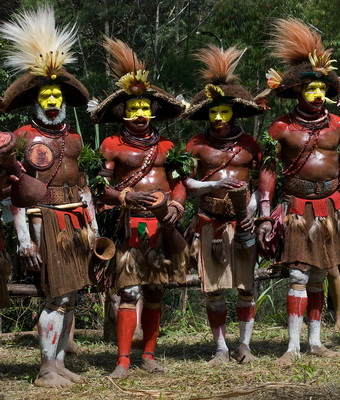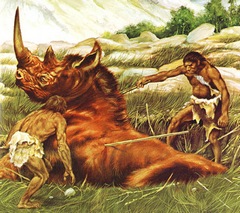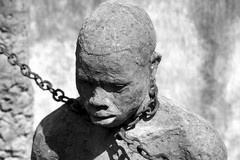|
The Human Evolution Hypothesis
Contents Select from the right to skip to the sections that interest you. |
|
The Big Picture
The hypothesis is made here that somewhere along the line of hominid evolution, an ape with a higher Violence Spectrum Personality Filter setting developed. (Remember, it is not suggested that single genes are responsible for each personality filter. This enhanced Violence Filter resulted in a hominid that would kill not only for food or defense, but also for advantage, out of irritation, or in extreme cases, for the sheer fun of it.
While frustrated or marginally violent behavior would have been seen in more passive hominid children previously, this was somewhat tolerated while they grew out of it to become more cooperative in adolescence or adulthood. And, while they may have had the typically mammalian male instinct to fight over mating rights with females, they did not kill each other intentionally... until our enhanced violence hominid variant arose on the scene.
Since the tribe only realizes our new hominid variant is "especially" lethal once of reproductive age (having both surpassed the period of tolerance for bad behavior and grown strong enough to actually kill the previously more powerful adults) the tribe is unable to intervene and eliminate him before he has had a chance to copulate and reproduce. Thus, this genetic trait is able to leak further into the offspring of the tribe, and eventually multiple hominids with an especially bad attitude are produced, and continue to be reproduced.
In fact, adult apes who will not only kill for their mate(s), but will also kill for their food and lodging when having difficulty securing their own would be expected to gradually increase the enhanced violence trait in the population as they out-compete their more passive counterparts.
(Note, the index observed hominid is recognized as male here. Violent females would and will also exist, but due to their strength profile, would not be experienced by the tribe as being as lethal as the males.)
The survival instinct is strong in many species, and we will presume was strong for these early hominids. Who might be more likely to survive the Violent Apes, and the families they are rearing? (We presume that the Violence Spectrum Personality Filter has genetic components in its genesis, and therefore that some of the offspring will have inherited similar tendencies.)
The Smarter Violent Apes will have better chances for survival against the Violent Apes.
And thus the "simply Violent" Apes themselves will have to become smarter in order to continue succeeding violently.
And the "simply Smarter" Apes will have to become more violent in order to prevail against the Violent.
These Smarter Apes and Violent Apes, since they mate with each other, are all one and the same ape grouping. It is not so much different apes we are talking about. We are discussing different ape filters. One for Violence, one for Intelligence or Cunning. Both working synergistically with one another.
Eventually, after a sufficient cycle of increasing Violence and Cunning, we wind up with a race of hominids that is significantly different from the community that had begat it so many generations ago. They don't get along with each other. In fact, these Smarter Violent apes are persona non grata to the hominids that came before them. If convenient, they parted ways and lived without hassling each other. If not convenient, then the Smarter Violent hominids wiped the earlier race out, thinking, "They were weird anyway."
So now what, you have an outcast race, destined to become another species after a sufficient amount of time. What's next?
Well, you have a group of Smart Violent hominids, who are probably good hunters, but will kill their own (if the numbers are big enough, let's call it war) if they perceive advantage in it (or fun.) What personality traits did they bring along with them from the earlier hominids, the one's earlier in their lineage?
Firstly, knowledge being limited, they then also brought with them the traits of Pattern Recognition, and Faith (which would be easily seen in the absence of Analytics). When we say Faith, we are not meaning religious faith or even faith in "gods" or "a god" or "The God" ... although we can't exclude that. Just no way of knowing. By Faith, we simply mean the ability to jump to conclusions and keep them based on other non-rational inputs, such as communication style, instincts, the existence of certain hopes and wishes, etc.
Faith and Superstition might have gone hand in hand. For example, knowing that you had caught food in Place A for the first time might cause you to hope (or conclude non-analytically) that there might be more food in Place A tomorrow. That might be a pretty good bet, even good enough for survival, even though it might not be based on Analytical facts, such as, "Food group X can be found in Place A because it is there that it needs to be if it is going to survive, and we have seen it reproducing there, or, it has always been there every time we looked."
So you have new hominids with increased intelligence (Smart), increased Violence, and sufficient Faith to hunt and survive with as they roam new places to call home.
Pretty soon something happens. As the group(s) get large enough, there is increased violence, leading to increased death by murder. The early hunter-gatherer environment was sufficiently difficult that this increased threat actually took its toll on the total numbers of hominids in the area. It also leads to morale and cooperation issues, also important for survival. And yet, it is also seen that if the group is large enough, some specialization in roles can occur that leads to things being much better off. One thing leads to another and you begin finding the Violent Alphas targetting each other, but letting the Violent non-Alphas - the Followers have some slack. The Violent Alphas understand that live Followers can be useful and they don't pose such an immediate threat. I'm not saying you had a group of Passives and Violents. Rather you had Violent and ExtraViolent. They'll all kill, just some more likely than others.
Now you get a personality profile bifurcation occurring. The ExtraViolent Alphas need cooperation from the Violent Cooperatives in order to ensure survivability (personal survivability) against other of the ExtraViolent Alphas in or nearby the tribe. The Cooperatives are fine with it as long as they get something out of it.
As these cooperative groups move through time, you see the following behavioral bifurcation occurring. More of the ExtraViolent Alphas are killed off by other of the ExtraViolent Alphas and their Cooperative Betas (Followers.) On average, the deciding factor in the killings are luck and intelligence. Assume both sides have equal luck, but not equal intelligence. Over time, intelligence wins, with inevitable setbacks along the way. And, even more of the Cooperative Betas are reproduced (what better way to grow an army!), who are Smart, but most importantly, Faithful. They do not have, on average, the ambition of the Alphas, as that would render them ExtraViolent Alphas (and a threat.) Rather, they are OK with the notion that if they just do what is required of them, they will be better off than the alternative. This is another positively adaptive trait.
You get another personality bifurcation going on as well. These hominids do not only kill for convenience. There are a lot of other things that one can do for convenience that the other animals do not do. Our Smart Violent Alphas also have no problem with enslavement.
Now, as far as enslavement goes, there are only a few ways that you are going to respond to that. If you are a Smart ExtraViolent Alpha with ambition, you are probably not going to respond well to being enslaved, probably will rebel at some point, and a fair number of you will be killed. If you are the Smart ExtraViolent Alpha that is doing the enslaving, then you are going to endeavor to save yourself the risk and trouble of a troublemaker by identifying other Alphas in the enslaved pack, and eliminate them. If you think the trait sorts with gender, then you may eliminate various of the related males as well. By the way, you may have been right regarding some aspects of the Alpha being related to gender, though, obviously, not all of it is. But, as a pattern recognizer, you (and your dogs) understand "good enough" pretty well.
Thus, out of the group destined to be slaves, the ambitious and the very smart are culled. The obedient and submissive multiply. And of course, along the way the enslaver may discover (it could have been an accidental association generated randomly in evolution) that the folks who are Faithful to the point of Religion are the easiest to keep submissive and cooperative. They just need to find the right Religion.
This is not to say that if there is a "guiding hand" that there is not a "One True Religion" that seeks to be in harmony with it. Could very well be. However, that would account for the One True Religion. How to account for the other thousands? Which one is the "One True." We are not suggesting that anyone knows the answer to that question, or that it is even an appropriate question to ask at all. Rather, what is being said is that the nature of religions that are based on a "guiding hand" that is never seen and never directly reveals itself is that ... its relatively easy for someone in need of manipulating to make one up as well.
This is how over time we wind up with a population spectrum that is mostly Faithful (it started off that way, and subsequently was overtly selected for) and minorly composed of Analytics (who are a threat to the powerful, or themselves may comprise the powerful.)
That a synergy developed between these can explain how the ratios seem to have been maintained over thousands of years (a few leaders, many followers.)
Last Update: Nov 14, 2014 16:00 PST